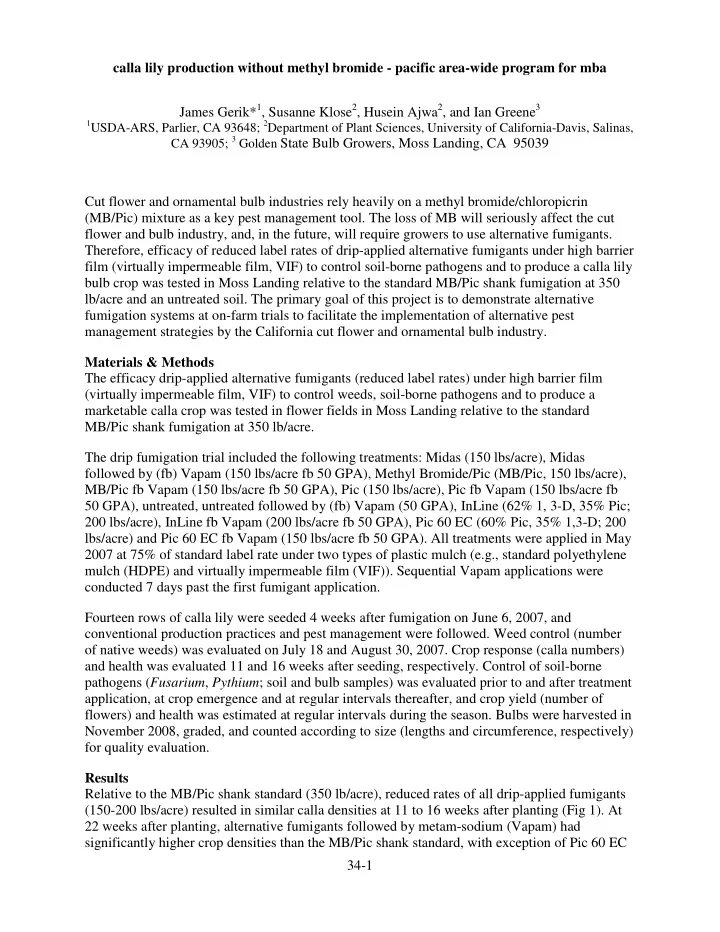

calla lily production without methyl bromide - pacific area-wide program for mba James Gerik* 1 , Susanne Klose 2 , Husein Ajwa 2 , and Ian Greene 3 1 USDA-ARS, Parlier, CA 93648; 2 Department of Plant Sciences, University of California-Davis, Salinas, CA 93905; 3 Golden State Bulb Growers, Moss Landing, CA 95039 Cut flower and ornamental bulb industries rely heavily on a methyl bromide/chloropicrin (MB/Pic) mixture as a key pest management tool. The loss of MB will seriously affect the cut flower and bulb industry, and, in the future, will require growers to use alternative fumigants. Therefore, efficacy of reduced label rates of drip-applied alternative fumigants under high barrier film (virtually impermeable film, VIF) to control soil-borne pathogens and to produce a calla lily bulb crop was tested in Moss Landing relative to the standard MB/Pic shank fumigation at 350 lb/acre and an untreated soil. The primary goal of this project is to demonstrate alternative fumigation systems at on-farm trials to facilitate the implementation of alternative pest management strategies by the California cut flower and ornamental bulb industry. Materials & Methods The efficacy drip-applied alternative fumigants (reduced label rates) under high barrier film (virtually impermeable film, VIF) to control weeds, soil-borne pathogens and to produce a marketable calla crop was tested in flower fields in Moss Landing relative to the standard MB/Pic shank fumigation at 350 lb/acre. The drip fumigation trial included the following treatments: Midas (150 lbs/acre), Midas followed by (fb) Vapam (150 lbs/acre fb 50 GPA), Methyl Bromide/Pic (MB/Pic, 150 lbs/acre), MB/Pic fb Vapam (150 lbs/acre fb 50 GPA), Pic (150 lbs/acre), Pic fb Vapam (150 lbs/acre fb 50 GPA), untreated, untreated followed by (fb) Vapam (50 GPA), InLine (62% 1, 3-D, 35% Pic; 200 lbs/acre), InLine fb Vapam (200 lbs/acre fb 50 GPA), Pic 60 EC (60% Pic, 35% 1,3-D; 200 lbs/acre) and Pic 60 EC fb Vapam (150 lbs/acre fb 50 GPA). All treatments were applied in May 2007 at 75% of standard label rate under two types of plastic mulch (e.g., standard polyethylene mulch (HDPE) and virtually impermeable film (VIF)). Sequential Vapam applications were conducted 7 days past the first fumigant application. Fourteen rows of calla lily were seeded 4 weeks after fumigation on June 6, 2007, and conventional production practices and pest management were followed. Weed control (number of native weeds) was evaluated on July 18 and August 30, 2007. Crop response (calla numbers) and health was evaluated 11 and 16 weeks after seeding, respectively. Control of soil-borne pathogens ( Fusarium , Pythium ; soil and bulb samples) was evaluated prior to and after treatment application, at crop emergence and at regular intervals thereafter, and crop yield (number of flowers) and health was estimated at regular intervals during the season. Bulbs were harvested in November 2008, graded, and counted according to size (lengths and circumference, respectively) for quality evaluation. Results Relative to the MB/Pic shank standard (350 lb/acre), reduced rates of all drip-applied fumigants (150-200 lbs/acre) resulted in similar calla densities at 11 to 16 weeks after planting (Fig 1). At 22 weeks after planting, alternative fumigants followed by metam-sodium (Vapam) had significantly higher crop densities than the MB/Pic shank standard, with exception of Pic 60 EC 34-1
(Fig. 2). Weed control of reduced rates of drip-applied fumigants was generally lower than the MB/Pic shank standard (Fig. 3). Weed control by alternative fumigants was improved if followed by Vapam 5-7 days after the first fumigant application. Pathogen control was significantly improved by all alternative fumigants relative to the MB/Pic shank standard. At 11 weeks after planting, Pythium was recovered from soils collected in the following treatments: untreated control (UTC), and UTC fb Vapam, Pic60 EC, and MB/Pic shank and drip- applied. Numbers of infected bulbs, randomly collected from entire plot area (N = 12) were 92% in the MB/Pic shank standard (350 lbs/acre), and ranged from 58% (MB/Pic, 150 lbs/acre) to 27% (Midas, 150 lbs/acre) in drip-applied treatments. In general, no infected bulbs were found if alternative fumigants were followed by sequential Vapam application (50 GPA). Bulb yield and quality data were evaluated after crop harvest in November 2008 (Fig 4). The greatest yield was obtained with Midas + Vapam treatments. Several of the other treatments had greater yields compared to the Mb/Pic shank treatment, the exceptions being the InLine/Vapam treatments and the Pic treatments. The addition of Vapam provided for greater yield except for treatments containing 1,3 –D where the treatments without Vapam outperformed those with Vapam. The VIF treatments generally had greater yields than the HDPE treatments. In summary, it appears that a calla lily bulb crop can be grown with low rates of alternative treatments. Present and future pesticide regulations could preclude the use of some of the combinations tested in this trial. 34-2
Figure 1. Calla density (No. plants per acre) 11 weeks after planting in drip-applied MB/Pic and alternative fumigants in the 2007/2008 field trial in Moss Landing, California. Figure 2. Calla density (No. plants per acre) 22 weeks after planting in drip-applied MB/Pic and alternative fumigants in the 2007/2008 field trial in Moss Landing, California. 34-3
Figure 3. Weed density (No. plants per acre) after application of drip-applied MB/Pic and alternative fumigants in the 2007/2008 field trial in Moss Landing, California. Figure 4. Bulb yields (value) relative to the MB/Pic flat fume standard fumigants in the 2007/2008 field trial in Moss Landing, California. 34-4
Recommend
More recommend